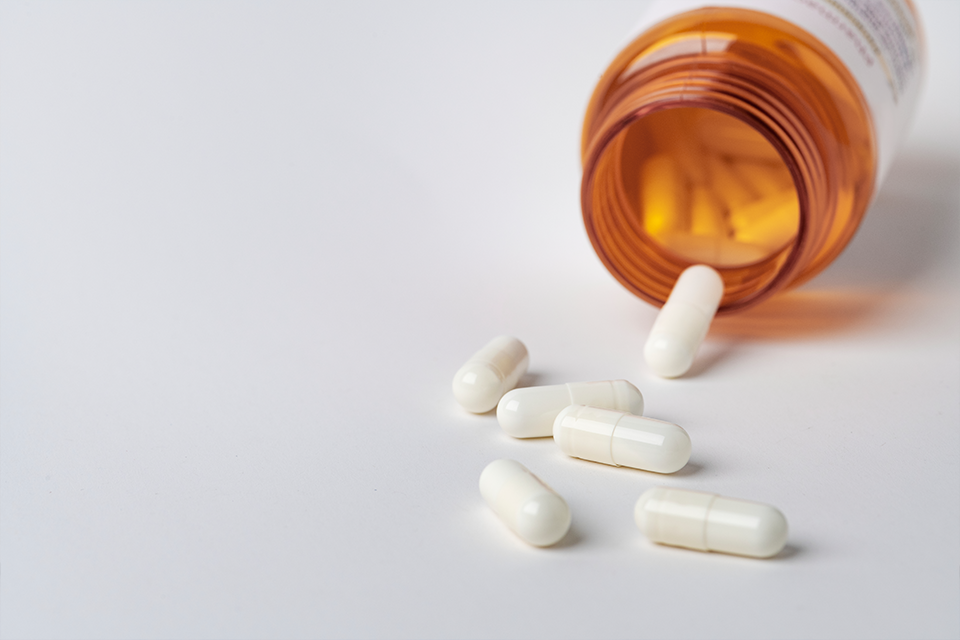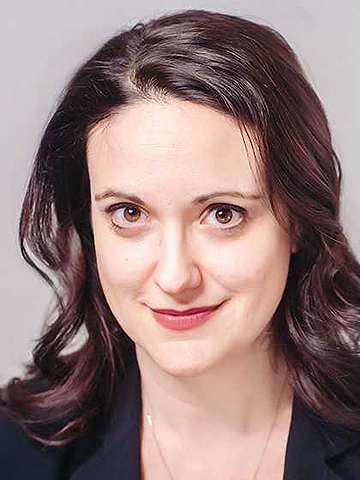SLU Professor Shows Ethical Duality of Using Prescription Drug Monitoring Programs in Fight Against Opioids
Saint Louis University’s Liz Chiarello, Ph.D., associate professor of sociology recently published an article in the American Sociological Review, the flagship journal of the American Sociological Association. The article explores pharmacists’ use of prescription drug monitoring programs (PDMPs) and the ethical and practical application of PDMPs in healthcare.

Prescription drug-monitoring programs (PDMPs) allow pharmacies to quickly determine if patients are misusing prescriptions, but also serve as law enforcement tools implemented in healthcare spaces. Stock photo by freepik.
Chiarello examined six states with various levels of resources dedicated to fighting the opioid crisis and studied how pharmacists in those states use PDMPs when filling prescriptions.
“I started this project because I saw healthcare and law enforcement trying to work together to combat the opioid crisis,” Chiarello said. “The prescription drug monitoring program was a lynchpin since it was a technology shared across fields. I wanted to understand how two fields, health care and criminal justice, dealt with the same social problem and how they worked together and at cross purposes in the process.”
PDMPs were introduced to give pharmacists a quicker and easier way to determine if patients were at risk of misusing their prescriptions. In practice, PDMP use fundamentally changed the way pharmacists interact with patients in four distinct ways: routines, relationships, roles and routes.
Pharmacy work is nearly always fast-paced and demanding. Before PDMPs, pharmacists had to rely on their own instincts and gather additional information to determine if a patient was misusing substances, processes that took time away from other tasks. With PDMPs, pharmacists can quickly access an algorithmic risk score which streamlines the process. Pharmacists can also use these PDMP reports to justify refusing to dispense opioids.
PDMPs also changed the way pharmacists interact with their patients, doctors and law enforcement. Before PDMPs, pharmacists were covert in defying the wishes of patients or doctors, and had few interactions with law enforcement. Now, can pharmacists collaborate with law enforcement and challenge physicians’ prescriptions.
Roles have changed as well, as pharmacists have embraced policing roles that conflict with their roles as treatment providers. Before PDMPs, pharmacists generally saw themselves as “medical gatekeepers” responsible for caring for patients. Today, pharmacists increasingly embrace “legal gatekeeping” roles that focus on rooting out patients who are breaking the law.
Finally, when it comes to PDMPs, pharmacies and pharmacists have changed what happens when patients do not receive their medication. In the past, patients were simply denied their prescription. Today, with the heavy use of PDMPs, pharmacists may directly lead law enforcement to those who are misusing pills. Patients denied medications may seek pain relief outside of the medical system which exposes them to a toxic and dangerous drug supply.
All of these point to why Chiarello refers to PDMPs as “Trojan Horse Technologies.” PDMPs were originally designed for law enforcement and given as a “gift” to healthcare via federal grants that funded the creation of statewide PDMPs. They were touted as a way to increase efficiency and accuracy within pharmacies, while better protecting patients from harm. According to Chiarello, though, PDMPs are not healthcare tools but rather enforcement tools implemented in healthcare spaces.

Liz Chiarello, Ph.D., has studied PDMPs and the opioid crisis for several years and sees a future for PDMPs where they are used as a healthcare tool rather than a law enforcement tool. File photo.
“Even though PDMPs resemble other healthcare technologies like the electronic medical record, they are fundamentally different because they are oriented around surveillance and enforcement,” Chiarello said. “These logics remain even as PDMPs make their way into healthcare fields. Like the Greeks embedded in the Trojan horse destroyed the Trojan civilization, enforcement logics embedded in PDMPs threaten to undermine the very core of healthcare. Not only are PDMPs shifting healthcare providers’ practices and commitments, but PDMPs make private healthcare data available to enforcement agents who use it to pursue legal cases against healthcare providers and patients. PDMPs, therefore, are a two-tiered surveillance technology that enables law enforcement to monitor patients and providers and enables healthcare providers to monitor patients.”
Chiarello added that if the core principle of PDMPs were patient care, then the information would be protected in healthcare records rather than made readily available to law enforcement.
“If what we cared about was tracking people's prescription drugs, and we wanted to do it in the healthcare system, we would put it in the electronic health record,” Chiarello said. “The reason it's in the PDMP, and the reason the Department of Justice paid a lot of money to create PDMPs, is because it's an end run around HIPAA. It's a backdoor through which law enforcement can access private medical records. PDMPs give law enforcement a trove of data that they couldn’t otherwise access. They've essentially deputized health care providers to do enforcement work.”
PDMPs have been in use by pharmacies since the 1940s, but did not become prevalent until the 2000s. They use a variety of factors to determine whether or not a patient could potentially be using scripts to misuse prescription drugs. Red flags can manifest in a number of ways, including paying cash for pills instead of going through insurance, having prescriptions from a number of different doctors, or having a high dosage. Naturally, not all patient circumstances are the same, and using solely these factors can disproportionately affect certain populations.
“There are quite a lot of red flags that could come up in PDMPs, and most are set by the DEA,” Chiarello said. “But these red flags do not necessarily indicate wrongdoing. It's poor and uninsured people who are going to pay cash. If you’re seeing different doctors, but you're going to the same practice, PDMPs don’t show that. People become tolerant of opioids over time and need higher doses to have an effect, so people who have been on them for a while are likely to be on high volumes. The algorithm takes all of that information and puts it into a single number, almost like a social credit score. It incorporates all of this information and can determine whether or not you ‘deserve’ access to medication. And the algorithm is a black box. No one except for the company that runs the PDMP knows exactly which factors go into the risk score”
Chiarello said there are a number of ways pharmacies can assist in the fight against the opioid crisis.
“The main problem is that policy makers have been so focused on bringing down prescribing rates that they have not focused enough on stopping overdose which is really the biggest problem,” Chiarello said. “Pharmacies should stock evidence-based medications like buprenorphine and naloxone that are critical for preventing overdose and getting people on the road to recovery.
“This is a social problem versus a legal problem,” Chiarello continued. “Diabetes is medicalized. We have an answer for it, we have a diagnosis. But we still treat addiction and pain as moral issues, and in some cases, criminal issues. However, the evidence base on substance use disorder shows that medications are the most effective approach. The problem is most doctors do not prescribe medications for substance use disorder. The other problem on the pharmacy end is that pharmacies don't carry them either. Making sure the medications that are the gold standard for treating substance use disorder are available in pharmacies is far more effective than policing your patient and sending them out of your pharmacy with nothing.”
Ultimately, throughout her research, Chiarello found pharmacists generally appreciated PDMPs, because the technology made their work more efficient and helped them avoid facing legal consequences for over-dispensing opioids. However, there was a significant cognitive dissonance between doing what is best for the patients and what is best for the pharmacist, an area Chiarello will explore further as the ethical and practical uses of PDMPs become more apparent as the opioid crisis rages on.
“PDMPs are imperfect technologies,” Chiarello said. “Looking at what the consequences of using PDMPs are, I believe we need an ethical adjustment and rethink what this tool is and what it can do. It could be used as a healthcare tool if it were used in the context of a healthcare system devoted to providing care. Currently, it is used in the context of enforcement where patients are being pushed out of care and left with nowhere to go. Hopefully, healthcare providers and administrators will correct the course and reaffirm their commitment to helping patients. After all, isn’t that what healthcare is all about?”
Latest Newslink
- Kathryn Mitchell Pierce, Ph.D.: 1955-2025Kathryn Mitchell Pierce, Ph.D., associate professor of educational studies, died Wednesday, Dec. 10, 2025. She was 70 years old. Pierce joined Saint Louis University in 2015 as an assistant professor in the School of Education. Initially a literacy specialist in the undergraduate program, she eventually taught and mentored across all levels at the School of Education. She became an associate professor in 2022.
- Saint Louis University Student Speaks About Leadership and Disability at Ignatian Family Teach-In for JusticeSaint Louis University senior Grace LoPiccolo shared her personal leadership journey at the 2025 Ignatian Family Teach-In for Justice. The event, held annually in Washington, D.C., is the nation’s largest Catholic social justice advocacy day.
- SLU Research Shows Surge in Alcohol-Related Liver Disease Driving ‘Deaths of Despair’Researchers at Saint Louis University School of Medicine say deaths from alcohol-related liver disease have surged in recent years, and the increase is hitting people without a college degree the hardest. While nearly every demographic group is seeing higher death rates—including those with college degrees—the gap between economically disadvantaged groups and more affluent ones is growing, according to new research.
- Saint Louis University Joins Multi-Disciplinary Research Team to Enhance Stress Resilience in SorghumSaint Louis University is part of a multi-disciplinary team, led by the Donald Danforth Plant Science Center, to deepen the understanding of sorghum, a versatile bioenergy crop, and its response to environmental challenges.The U.S. Department of Energy (DOE) Biological and Environmental Research (BER) program supports the three-year $2.5 million project for Genomics-Enabled Understanding and Advancing Knowledge on Plant Gene Function. Saint Louis University will receive $437,039 for its portion of the study.
- SLU Graduates Celebrated at Midyear CommencementSaint Louis University celebrated its Midyear Commencement on Saturday, Dec. 13, inside Chaifetz Arena. More than 1,900 guests watched as 600-plus SLU students walked across the stage and left as graduates.
- Why Do Raccoons Cross the Road? SLU, St. Louis Zoo Research Shows They Don'tA new study led by researchers from Saint Louis University, the Saint Louis Zoo, and partner organizations set out to understand how raccoons use space in one of the nation's largest urban parks.













